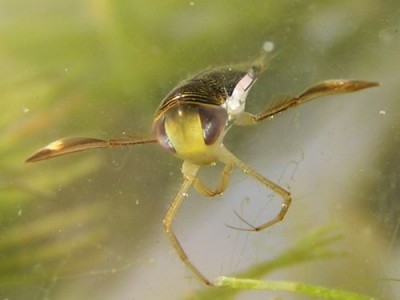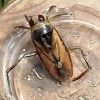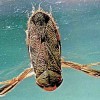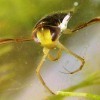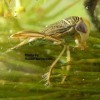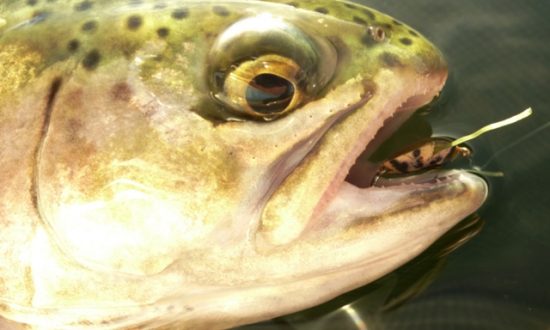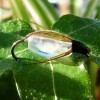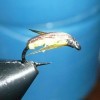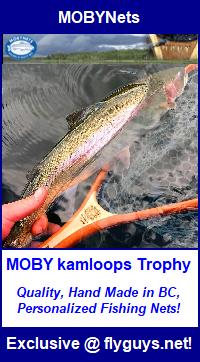Fly Fishing Boatman & Back Swimmers …
In the beautiful BC Interior the Water boatman/back swimmers are an important part of a trouts diet; which means fly fishing water boatman and back swimmers is important for fishermen. Do your self a favour and learn all you can about fly fishing boatman & back swimmers! 😉
Water Boatmen are aquatic bug members of the Corixidae family. They are mostly plant-eating insects but also eat algae and other small aquatic organisms. Some are predaceous and feed on mosquito larvae and other small aquatic animals. In turn, boatmen are important prey for many larger aquatic animals.
Water boatmen have elongated oval bodies and can grow to about 12mm long. They have broad heads with large eyes, short flat front legs and long skinny middle legs, but are most recognizable by their oar like hind legs.
The Boatman inhabits ponds and slow moving streams, where they swim right side up near the bottom. Similar to the back swimmer, they swim with two long legs that look like oars. There are approximately 525 species known worldwide, 132 in North America alone.
Fly Fishing Boatman & Back Swimmers | Behavior:
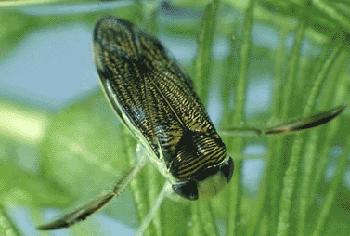 Water Boatmen have a one year life cycle and two stages of development – nymph and adult. In both stages the water boatman are near identical except that the adults have wings and the nymphs do not. Nymphs develop through five growth stages, or instars, and have incomplete metamorphosis. Both the nymph and adult boatman live in the shallows up to 6 feet, preferring weedy areas for cover.
Water Boatmen have a one year life cycle and two stages of development – nymph and adult. In both stages the water boatman are near identical except that the adults have wings and the nymphs do not. Nymphs develop through five growth stages, or instars, and have incomplete metamorphosis. Both the nymph and adult boatman live in the shallows up to 6 feet, preferring weedy areas for cover.
Water Boatmen have no gills so must frequently swim to the surface to grab a bubble of air and swim back down where they survive by drawing oxygen from the bubble while they are underwater.
To accomplish this they use their strong paddle like hind legs like oars to carry the bubble on their body surface or under their wings, which not surprisingly makes for quick but erratic swimming.The bubble often gives the boatman a very shiny appearance, a trait that should not be over looked by fly fishermen. 😉
Water boatmen are very common in most trout waters and available to fish year round. However, they are largely ignored by trout except during their mating frenzy in the early spring at or near ice off, and again in the late fall during their migratory flights. Trout will also feed on them when forage for other insects is scarce.
Water boatman mate in early spring, around ice off, with erratic behavior around the surface of the lake. In the fall, around the first frosts, they fly off on a migratory flight dispersing themselves to other waters. At the end of their flight they splash down like rain into any part of a lake, stunned for a few seconds they recover and swim off to the safety of the shallows. It is during these times that the boatman has the trouts full attention, and the observant fly fisher focusing on this aquatic bug now will reap the rewards.
Water boatmen are sometimes confused with back swimmers, which are generally larger bugs that swim upside down and, unlike the water boatmen, can deliver a painful bite.
Fly Fishing Boatman & Back Swimmers | Presentation:
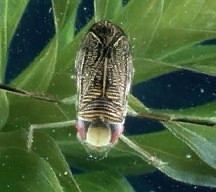 Depending on depth of water and the presentation you are trying to achieve, both floating and sinking lines can be used to fish water boatmen patterns.
Depending on depth of water and the presentation you are trying to achieve, both floating and sinking lines can be used to fish water boatmen patterns.
Floating Line: Use a floating line with a short leader/tippet in shallows to 6 feet with a tippet size between 4x to 6x. To present below the surface use a sinking dressing, sinking tippet or weighted fly.
Attach enough tippet to allow the fly to reach the lake bottom, cast to the shallows, let it settle and retrieve to imitate a boatman rising to the surface. Move the fly along in quick jerks of 2-4 inches per second. Pause every 5 to 10 jerks for 2 to 3 seconds and repeat. During their migratory flight crashes, the boatman becomes momentarily stunned before swimming off. When this behavior is observed, Cast to rising fish, pause a few seconds and then retrieve.
Sinking Line: Use a slow sinking line, type I or II, with a short leader and tippet of 4x to 6x.
When fly fishing boatman or back swimmers with a sinking line, to imitate the the swim back down with an air bubble, dress the fly, leader and even a few feet of the wet line with floatant. Cast to where you suspect fish to be, let the undressed portion of the line sink until it begins to pull the fly under, and then retrieve with short jerks to imitate the fly struggling back down with a bubble of air. Pausing every 5 to 10 jerks will cause the fly to float back towards the surface further imitating it’s struggle with the air bubble.The boatman is most vulnerable just after it picks up a bubble of air so be ready as trout usually strike the fly near the surface on or at the on it’s way back down.
Fly Fishing Boatman & Back Swimmers | Fly Patterns:
Corixid, boatman and back swimmer patters. Size 10 – 16 in shades of black, brown, tan and green. Keep in mind that the underside of the boatman is usually a lighter shade of its backside and don’t forget about the air bubble! 😉
Fly Fishing Boatman & Back Swimmers: Some of Our Fly Patterns:
Fly Fishing Boatman & Back Swimmers | Fly Tying Posts:
……. fly patterns coming soon!
Fly Fishing Boatman & Back Swimmers | YouTube Video Playlist:

